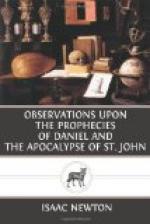Constantinople was free from these superstitions till Gregory Nazianzen came thither A.D. 379; but in a few years it was also inflamed with it. Ruffinus [7] tells us, that when the Emperor Theodosius was setting out against the tyrant Eugenius, which was in the year 394, he went about with the Priests and people to all the places of prayer; lay prostrate in haircloth before the shrines of the Martyrs and Apostles, and pray’d for assistance by the intercession of the Saints. Sozomen [8] adds, that when the Emperor was marched seven miles from Constantinople against Eugenius, he went into a Church which he had built to John the Baptist, and invoked the Baptist for his assistance. Chrysostom [9] says: He that is clothed in purple, approaches to embrace these sepulchres; and laying aside his dignity, stands supplicating the Saints to intercede for him with God: and he who goes crowned with a diadem, offers his prayers to the tent-maker and the fisher-man as his Protestors. And in [10] another place: The cities run together to the sepulchres of the Martyrs, and the people are inflamed with the love of them.
This practice of sending reliques from place to place for working miracles, and thereby inflaming the devotion of the nations towards the dead Saints and their reliques, and setting up the religion of invoking their souls, lasted only till the middle of the reign of the Emperor Theodosius the great; for he then prohibited it by the following Edict. Humatum corpus, nemo ad alterum locum transferat; nemo Martyrem distrahat, nemo mercetur: Habeant vero in potestate, si quolibet in loco sanctorum est aliquis conditus, pro ejus veneratione, quod Martyrium_ vocandum sit, addant quod voluerint fabricarum. Dat. iv. Kal. Mart. Constantinopoli, Honorio nob. puero & Euodio Coss._ A.C. 386. After this they filled the fields and high-ways with altars erected to Martyrs, which they pretended to discover by dreams and revelations: and this occasioned the making




